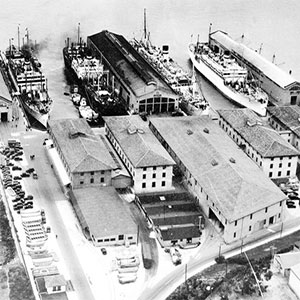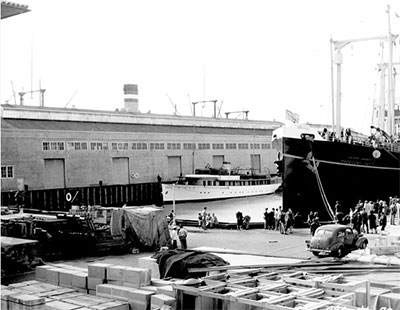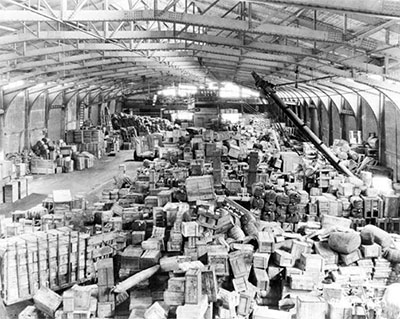Introduction
The San Francisco Port of Embarkation served as the army’s major West Coast shipping port and giant supply funnel, providing provisions to remote military outposts from 1915 through the 1950s. During the 45 months of World War II, this port was responsible for a staggering amount of shipping and transportation: over 1,600,000 military men and women and more than 23,500,000 ship tons of material left these docks and sailed through the Golden Gate on their way to islands in the Pacific Ocean.
The Need to Ship Goods to the Pacific

National Park Service
Originally named the General Depot, the creation of the San Francisco Port of Embarkation represented a dramatic shift in the nation’s military focus. Until the end of the 19th century, the United States had never fought a significant war overseas; most of its political and economic struggles were internal. However, with the advent of the Spanish-American War in 1898, the U.S. sent men into battle in the Philippines, thousands of miles from home. Within a very short time, America went from a country focused on its own affairs to an international power, one with troops and permanent overseas garrisons in the Philippines, China, and the Hawaiian Islands. As a result, every supply that these far-flung American troops needed had to be delivered to them by large, ocean-going cargo ships.
In the early 1900s, the army managed their shipping needs by renting private docks and warehouses along the San Francisco waterfront. Unfortunately, most of these docking facilities were destroyed in the devastating 1906 earthquake. Desperate for functional shipping space, the War Department quickly authorized the construction of an army general depot in San Francisco.
The army identified Fort Mason as the ideal location for the new general depot. Originally established in 1851 to take advantage of its strategic location, Fort Mason had been fortified during the Civil War to protect gold-laden commercial sailing ships from Confederate attack. Below Fort Mason, a quiet inlet with favorable currents and a small beach in handy proximity to the city’s railroad systems provided an excellent location for this new depot – and in 1910, construction of piers, storehouses and seawalls began.
How the Port Functioned
The General Depot was responsible for making sure that enlisted men stationed in the Pacific had enough food, medical and office supplies, ammunition, trucks, communication equipment, and even horses and mules, to fulfill their duties. The army specifically designed the depot buildings to get both soldiers and cargo on transport ships as quickly as possible. Each day, trucks and trains delivered hundreds of thousands of ship tons (each equivalent to 40 cubic feet of cargo) to the depot; trains carrying food and other supplies ran directly into both the pier sheds and the warehouses. The minute a fully loaded cargo ship pulled away from a pier, an empty one took its place. With proper coordination, as many as four individual transport ships could be loaded simultaneously. Any delay could easily backed-up the whole sequence, resulting in expensive mistakes. For example, fresh food not immediately put in the ships’ refrigerators would rot while sitting on idling trucks. In 1932, the Fort Mason General Depot was renamed the San Francisco Port of Embarkation (SFPE)
The SPFE’s Role During WWII

National Park Service
By the late 1930s, world war threatened and President Franklin Roosevelt launched the country into a massive mobilization effort to quickly modernize the army and navy’s outdated resources. The SFPE had been working well as the supply pipeline to the Pacific Islands. However, as more and more men were assigned to Hawaii, the Philippines, and other island outposts, a new and enormous demand for overseas supplies developed.
The surprise attack on Pearl Harbor on December 7, 1941, dramatically tested the functionality of the San Francisco Port of Embarkation. At first, there was chaos at the port when all Hawaii-bound transport ships were immediately ordered to return to San Francisco. More than 16,000 combat-ready soldiers found themselves back on land, and the army frantically re-assigned them to Bay Area posts until their new orders came through. With piers occupied by too many fully loaded ships, the port was a wild scene of rushing men, frenzied dockworkers, and rotting food.
However, this strange and alarming period kicked operations at the port into high gear, and some great good emerged: because so many ships, soldiers and supplies were available and unharmed in San Francisco, the port was in a unique position to organize the first Hawaiian relief efforts. On December 16, the army sent out three of its fastest available ships, each loaded with officers, soldiers, medical supplies, food, navy repair supplies, machine-gun ammunition, airplanes, and bombs. This convoy was the first to reach Oahu after the attack on Pearl Harbor.
The Need for Additional Shipping Facilities

National Park Service
During World War II, the original lower Fort Mason facility could no longer handle this flood of troops and cargo. To increase its shipping capacity, the army quickly constructed additional port installations around the Bay Area, leasing berths and terminal facilities in Richmond, Benicia, Eureka, Stockton, and the Alameda Estuary and constructing new troop staging areas including Camp Stoneman in Pittsburg and Fort McDowell on Angel Island. The sprawling port at the Oakland Army Base, the army’s largest new facility, had far more space for staging cargo and better direct access to the railroad system than Fort Mason. Able to accommodate sixteen ships at one time, the Oakland Army Base dramatically opened up the flow of supplies and was incorporated as a sub-port under SFPE’s command. During WWII, the SFPE’s administrative headquarters at upper Fort Mason oversaw all of these additional shipping facilities with its more than 30,000 military and civilian employees.
Last updated: November 9, 2015
